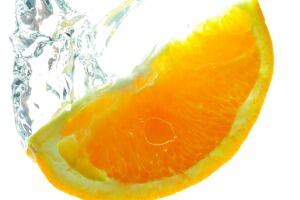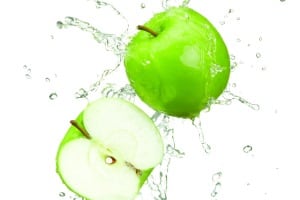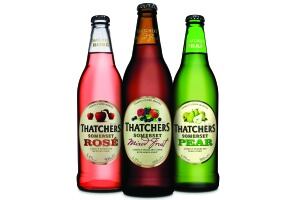Not so long ago, the average pub’s cider offering was restricted to pints of interchangeable big, bitter-sweet brands.
The combined impact of Magners, Swedish-led fruit ciders and the entry of big beer brands into the category has changed all that and packaged ciders have become a must-stock accessory for every pub fridge.
CGA Strategy figures put packaged cider ahead by 4% in volume in the year to 13 July, and a faster rate of value growth, at 10.3%, suggests it’s a category where licensees can expect to claim bigger margins.
Fruit flavours now claim five of the top 10 spots by value and Kopparberg’s Mixed Fruits pushed the original apple Magners off the number-one spot during the year, despite a drop in sales of 6.4%.

Bulmers No 17 — recently rebranded as Red Berries & Lime — secured number-three spot, ahead of parent brand Bulmers Original.
Strawberry & Lime is proving to be an enticing combination for modern cider drinkers with both Kopparberg and Rekorderlig’s offerings joining No 17 in the top 10.
CGA account director Graeme Loudon says: “The fruit sub-category has done well as a result of offering a sweeter-tasting drink, which seems to be popular with consumers across many categories.”
Thatchers launched a revamped fruit-cider range in bottles in the spring and managing director Martin Thatcher thinks fruit cider is still under-represented in the trade. He says: “It’s surprising that, with fruit ciders generating in the region of 16% of revenue for outlets, they are still only being given around 8% of the space in the fridge.”
Gemma Copping, marketing director for Rekorderlig at Chilli Marketing, says fruit-cider sales are helping the total cider category.
She says: “We know that 57% of consumers who are drinking Rekorderlig are new to the cider category. It can only be healthy for cider as a whole because they will use fruit as an entry point and move on to other ciders.”
The other rising star in the packaged cider top 10 is Stella Artois Cidre, which has chalked up more than £36m of the total market’s £720m sales, to claim sixth place.
Its relative success has prompted Molson Coors to follow its lead with its Carling British Cider and Carlsberg to do the same with Somersby. All three kicked off their cider challenges with an apple variant, with initial focus in the take-home market.
In August, Brothers launched the world’s most creative petition. “Instead of signatures, Brothers gathered lemons — hundreds of lemons — drawn on and submitted by Brothers drinkers,” says Cheryl Sheppard, consumer marketing manager at Brothers Drinks.
“Thousands of consumers added a lemon to convince pubs and shops to start selling it again, and it worked. Brothers has now taken orders from a number
of regional wholesalers,” explains Sheppard, hinting that licensees will soon be able to get their hands on this much missed flavour. “The new batch has been called ‘Cloudy Lemon’ but it’s the same great flavour the consumers know and love,” she adds.
10.3%
the value growth in packaged cider in the year to 13 July
Glen Friel, sales and marketing director at Kingstone Press supplier Aston Manor, says: “The rise in popularity of bottled cider is partly because the packaged form is the best and easiest way to add new products, as you can just put the bottles in the chiller and don’t have to change or add fonts on the bar.
“But bottled ciders are also the format that a lot of people are familiar with from the take-home sector, which is where a lot of customers might first encounter a brand.”
Craft ciders are also making their presence felt in on-trade fridges, with Suffolk producer Aspall seeing its packaged sales grow from just over £3m to £9.4m in the course of a year, according to CGA.
Loudon says: “Apple cider has looked to stage a comeback in recent times, with premium, craft and value brands entering the market and enjoying success.”

This goes hand in hand with Westons reinvigorating its Wyld Wood Organic Cider range, giving the brand a brighter personality and emphasising its place within Westons’ premium cider portfolio.
The new packaging is an “evolution rather than a revolution” of the previous design, which has been simplified and sharpened to give better shelf standout and presence. “The alcohol content has been harmonised and will now have a uniform 6% ABV across the range, which based on MAT volumes will effectively remove just under two million units of alcohol from the market,” according to the company.
6%
the ABV content across Westons’ Wyld Wood organic ciders range
Ian Lewis, head of marketing at Westons says: “It was clear we needed to evolve the organic cider’s packaging to deliver a clearer message to the consumer while reinforcing product quality. The new elegant and contemporary look is designed to reinforce and emphasise the quality of the cider in the bottle. Furthermore, we take social responsibility seriously so reducing the ABV of Wyld Wood was important in meeting the corporate social responsibility objective of reducing the number of units in the market.”
The Westons roundel is now prominent on the front of the bottleneck, providing consumers with the reassurance of quality that is associated with the Westons name. The main focal point of the label remains a large ‘W’, which is now used as the capital letter for both Wyld and Wood, binding the design together. This logo is also brighter and bolder than before, contrasting with the muted ‘organic’ tones of the background of falling leaves, and ‘Organic Cider’ is now written boldly to give a clear message on the shelf. A new addition to the label is the inclusion of a man pulling a chariot of apples or pears, adding more personality to the Wyld Wood brand.
"We expect the market to mature and there’s an opportunity for a more crafted contemporary offer"
Other cider companies are following suit and investing more in their brand image, targeting the premium market. For instance, Merrydown is relaunching its apple cider into the on-trade this month after a break of several years of exclusively off-trade distribution.
The brand is adopting a more contemporary look to reflect what head of brand marketing Amanda Grabham says is a consumer perception of the brand name as “light-hearted”.
“We expect the market to mature and there’s an opportunity for a more crafted contemporary offering,” she adds. “There are a lot of modern ciders out there, but as the market matures consumers will be looking for something a little more discerning.”
With such a proliferation of brands and fridge space limited, it can be hard for hosts to get the balance of the range right, both within cider and against competing categories.
Andrew Turner, on-trade category and trade marketing director at Bulmers supplier Heineken, says: “It’s important that licensees read the marketplace and take into account their location and customer footprint before adding ciders.
“Take the time to engage with your customers, ask them what brands they want, and stock accordingly.
“With 45% of consumers admitting they don’t know what they will order until they get to the bar, it’s important to ensure your range is visible.”
Copping at Rekorderlig adds: “We recognise that publicans don’t have ever-expanding fridge space and our rolling limited editions are aimed at helping them to have innovation. We have a summer limited edition, which is then replaced by our winter cider working in the same space in the fridge.”
Sheppard says: “Brothers Toffee Apple Cider was originally created for winter, but is now Brothers’ fastest-growing stock-keeping unit (SKU), and has quickly become the people’s favourite all year round,” making it more than just “the perfect accompaniment to Halloween”, and showing ciders now have broader appeal than just on certain seasonal occasions.
Many cider producers are trying to position bottled cider as a food-match alternative to wine or beer. “The fruit character and a taste profile that ranges from dry to sweet and from light to full-bodied make cider or perry a very versatile companion to different food groups,” says Friel at Aston Manor.
Rob Calder, head of marketing at Kopparberg, adds: “Although cider has historically under-indexed with food, there are signs that this is changing with the number of meal-deals that can be seen across the trade, especially in managed pubs.
“Consumers have benefited, for example, from Kopparberg meal-deals in Orchid’s Pizza Kitchen & Bar outlets.”
Report confirms battle of the brands
The bottled-cider category has made some significant gains this year. Fruity ciders, in particular, have helped give brands a boost in pubs and this was reflected in this year’s recent Brands Report.
Not only did the report include 28 varieties of cider from 17 different brands — which should go some way to illustrating the success of cider sales in pubs — but it also showed a strong presence for brands like Strongbow, Bulmers, Rekorderlig, Stella Artois Cidre, Stowford Press, Kopparberg, Thatchers, Magners, Aspall, Westons and Symonds Founder’s Reserve.

Traditional-style ciders are having to fight to keep up with competition from the fruitier, modern ciders being launched. However, some argue that innovation in cider (in whatever shape or form) is a good thing for all, since it generates more interest in the category for everyone.
While some brands begin to up their game this year, the positioning of bottled ciders, the trends seen within the category and also the emphasis of what is a priority in many a pub fridge begin to come into play.
This report serves to highlight that things in the cider category really have changed for good.
Anthony Mills, head of European marketing for Savanna Cider, says: “The category is becoming increasingly crowded. With many new entrants in the market, it is becoming more difficult for brands to differentiate from competitors.
“Cider is a strong impulse purchase, so it will deliver incremental sales if chillers are well stocked with popular brands as we head towards the autumn. Get the right balance of styles and brands to suit your customer profile.”
